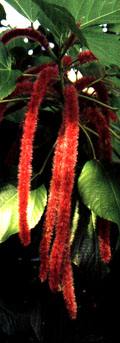 |
The Best of the Rest
Who can possibly keep up with all the material appearing each month? I don't claim to be able to, but here are a few pieces that really should not be missed. |
|
|
Many people
fail to get their full money's worth from their holiday poinsettias.
The simple rules for getting them to last:
|
||
|
Is it as good as it looks? Marc van Sittert,
a South African nurseryman, has a very thought- provoking article
in the November 2000 issue of Floraculture International.
He questions
whether nurserymen and retail stores have put enough attention into
giving their interior plant product a reasonable life expectancy
when the customer gets it home. Why does this happen? Van Sittert suggests that the grower's evaluation of quality is based on producing a fantastic looking plant. The conditions that grow this great plant in the nursery, however, may be so different from what the plant will experience in even a home chock-a-block with green thumbs and fingers, that the plants are doomed to a downhill slide. He cites several South African nurseries who have modified their cultural practices, including a movement away from completely soilless mixes. They try to produce plants that will bridge more easily the switch from the environment of technically excellent management in the nursery to that of a reasonably well-informed buyer. Floraculture International is published by Ball Publishing, Batavia, IL Their website www.floracultureintl.com is being expanded, and will soon archive articles from back issues of the magazine. [Editor's commentary. This problem of the contrast between growing conditions in the greenhouse and those in the client's site have been faced over the years by the producers of interior plants in the United States and Europe. The growing medium may still be at the base of some problems, as pointed out by van Sittert, but other factors such as reducing fertiliser load, and acclimatisation to light conditions have been addressed very successfully.] |
||
|
Hans Gerritsen, writing in the August 2000 of GMPRO, brings to our attention the increasing use of cyclamen as a bedding plant in the west and south of the United States. Crop time for a 4-inch pot from a plug is about three months starting in June to September for bedding use in the fall, and the plants need about the same treatment as other cool-season crops such as primulas, stock and ranunculus. Recommended fertilization is at EC 1-1.2 with 125-200 ppm nitrogen in constant feed, leaching with clear water each third application. Use a i:2 to 1:5 ration of N:K, with nitrogen in the nitrate form rather thn ammonium to avoid soft growth. A number of mini series are available: Latinia from Morel, Laser from Goldsmith and Libretto and Rondo from Novartis. Canto, also from Novartis, Garden Dance from PanAmerican, Intermezzo from De Ruiter and Metis are slightly larger in growth form and flower. GMPRO is one of a series of horticultural magazines from Branch-Smith Publishing. They have an extensive website at www.greenbeam.com. Hans A. Gerritsen is president of Hortus Group with a website at www.HortusGroup.com |
Back to Table of Contents